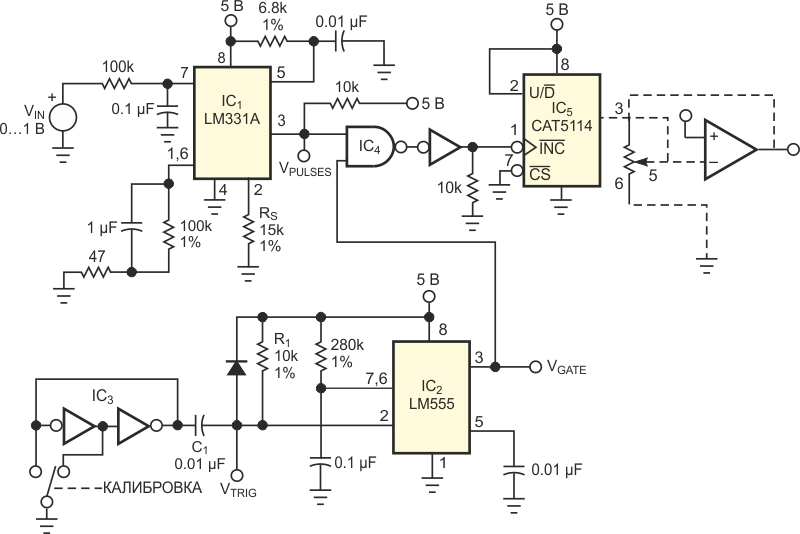The circuit in Figure 1 converts an analog input voltage, VIN, to a proportional wiper setting of a DPP (digitally programmable potentiometer). The potentiometer's wiper setting, which varies from position 0 through 31, corresponds to the input voltage, which varies from 0 to 1 V dc. The CAT5114, IC5, is a 32-tap potentiometer with an increment/decrement interface. VIN typically models the output voltage of a sensor whose value sets a parameter of an analog circuit in the signal-processing portion of a system. The basic principle of the circuit is to convert the input voltage to a number of pulses and let each pulse advance the potentiometer's wiper within a certain period of time. IC1 is a voltage-to-frequency converter. This circuit converts the 0 to 1 V dc input voltage to an output frequency, VPULSES, that varies from 0 to 1 kHz.
 |
||
| Figure 1. | You can convert an analog voltage to a wiper setting in a digitally programmable potentiometer. |
|
This free-running oscillator advances the wiper of the potentiometer for only 31 msec, established by VGATE and the AND function of IC4. VGATE is the output of the one-shot multivibrator, IC2. The one-shot receives its trigger from a calibrate switch or an external signal. The hex inverters of IC3 debounce the calibrate switch. R1C1 differentiate the voltage-level shift generated by the switch to provide a nominal 100-µsec trigger, VTRIG, to IC2. VTRIG could also be a processor-generated logic signal. The 31-msec gating signal is chosen to correspond to the highest tap position of the potentiometer at the highest frequency of the voltage-to-frequency converter. For a 100-tap potentiometer, the gating signal measures 99 msec for the same sensitivity of the voltage-to-frequency converter. You can trim the 15-kΩ resistor, RS, to match the timing of the 331 converter to the pulse width of the 555.
Tap position 00 of the digitally controlled potentiometer is stored in the DPP's nonvolatile memory and the potentiometer's up/down control is set to up. When the DPP powers up, the IC recalls wiper setting 00 from nonvolatile memory. When you depress the calibrate switch, the wiper increments from 00 to a setting corresponding to the input voltage, VIN. You can use the three-terminal resistive network of the potentiometer to control the gain of an amplifier (shown in broken lines in Figure 1), a parameter of a filter, or the coefficient of a mathematical operator.